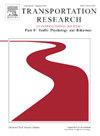预测现实驾驶中的车道变化:分析高速公路上的显性、隐性和上下文线索
IF 4.4
2区 工程技术
Q1 PSYCHOLOGY, APPLIED
Transportation Research Part F-Traffic Psychology and Behaviour
Pub Date : 2025-07-04
DOI:10.1016/j.trf.2025.06.023
引用次数: 0
摘要
驾驶员之间意图的沟通依赖于显性线索和隐性线索。虽然这些线索已经在城市环境中得到了广泛的研究,但它们在高速公路驾驶中的应用仍未得到充分的探索。这一差距在变道场景中尤为明显,在变道场景中,通信故障(如无法准确预测即将发生的变道)可能导致重大的安全风险。此外,尽管上下文线索在理论上发挥了重要作用,但对其影响的实证研究有限。我们的研究结果开始填补这两个空白,通过调查司机如何预测高速公路上的车道变化,考虑显性、隐性和上下文线索。我们采用自然驾驶研究(NDS)方法,其中30名参与者在日常驾驶中记录了798种相关的变道情况。数据是通过装有实时语音和视频录制定制应用程序的智能手机收集的。研究结果强调,有效的沟通主要依赖于隐性线索,例如车辆的纵向和横向运动以及运动模式,驾驶员使用这些线索来预测驾驶行为。上下文线索,包括车辆间距等动态线索和更广阔的交通环境等静态线索,在形成驾驶员的预测中起着次要作用。有趣的是,驾驶员在决策过程中很少使用显性线索,这凸显了显性线索在高速公路场景中沟通中的有限作用。这些结果支持了模仿人类行为的自动驾驶风格的发展,这可能会导致自动驾驶汽车对人类驾驶员来说更加直观和可预测,无论是在自动驾驶汽车内还是在周围的交通中。本文章由计算机程序翻译,如有差异,请以英文原文为准。
Predicting lane changes in real-world driving: analysing explicit, implicit and contextual cues on the motorway
Communication of intention between drivers relies on explicit cues and implicit cues. While these cues have been extensively studied in urban environments, their application to motorway driving remains underexplored. This gap is particularly evident in lane change scenarios, where communication failures such as the failure to accurately predict an imminent lane change can result in significant safety risks. Furthermore, although contextual cues are theorised to play an important role, empirical studies of their influence are limited. Results of our research start to fill both gaps by investigating how drivers predict lane changes on motorways, considering explicit, implicit and contextual cues. We utilized a Naturalistic Driving Study (NDS) approach, wherein 30 participants documented 798 relevant lane change situations during their daily drives. Data was collected through smartphones equipped with a custom app for real-time voice and video recording. The results highlight that effective communication relies primarily on implicit cues, such as longitudinal and lateral vehicle motion and movement patterns, which drivers use to predict driving behaviour. Contextual cues, including dynamic cues such as vehicle spacing and static cues such as the wider traffic environment, play a secondary role in shaping drivers’ predictions. Interestingly, explicit cues were rarely used by drivers in their decision making, highlighting their limited role in communication in motorway scenarios. These results support the development of automated driving styles that emulate human-like behaviour which could lead to automated vehicles that are more intuitive and predictable for human drivers, both within the automated vehicle and in the surrounding traffic.
求助全文
通过发布文献求助,成功后即可免费获取论文全文。
去求助
来源期刊
CiteScore
7.60
自引率
14.60%
发文量
239
审稿时长
71 days
期刊介绍:
Transportation Research Part F: Traffic Psychology and Behaviour focuses on the behavioural and psychological aspects of traffic and transport. The aim of the journal is to enhance theory development, improve the quality of empirical studies and to stimulate the application of research findings in practice. TRF provides a focus and a means of communication for the considerable amount of research activities that are now being carried out in this field. The journal provides a forum for transportation researchers, psychologists, ergonomists, engineers and policy-makers with an interest in traffic and transport psychology.

 求助内容:
求助内容: 应助结果提醒方式:
应助结果提醒方式:


